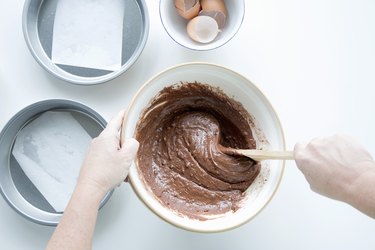
Cakes usually rise more in the middle, creating a dome to the cake. Cracking is also among cake problems for some bakers. While you can cut off the domed, cracked area of the cake, steps you take during mixing and preparation — such as using cake strips — reduce or eliminate the concern.
A little experimentation with cake baking helps you understand the subtle difference in your own oven that affects how cakes bake and rise. The adjustments you make produce a delicious cake without a dome on top.
Video of the Day
Video of the Day
Read more: How Do I Make a Cake Extra Moist?
Step 1: Check Oven Temperature
Measure the temperature of your oven with an oven thermometer to make sure it heats accurately, as recommended by New Mexico State University Cooperative Extension Service. Measure the temperature in different areas to see if it heats evenly.
An oven that is too hot makes the cake dome faster and crack — or even a burnt cake.
Step 2: Preheat the Oven
Heat the oven to 325 degrees Fahrenheit. Most cake mixes and recipes recommend 350 F, but the lower temperature prevents the cake from rising rapidly and cracking.
Step 3: Prep the Ingredients
Measure the ingredients as indicated in the recipe or on the cake mix box. Improper amounts or throwing off the ratio of ingredients affects how the cake bakes and may cause a high center or cracking.
Step 4: Mix Ingredients Together
Mix the ingredients according to the directions. Avoid over-mixing, which introduces extra air that may contribute to cracking and doming. Tap the filled cake pan gently on the counter before baking to help release air bubbles trapped in the batter.
Step 5: Use Cake Strips
Place special baking strips around the pan that help the cake bake more evenly. The strips are available at craft and specialty stores that sell cake-decorating equipment.
Step 6: Add a Flower Nail
Spray a flower nail with cooking spray. Press it into the middle of the cake batter with the large, flat side down toward the bottom of the cake pan, until it touches the pan.
This is particularly helpful in larger cakes because the nail conducts heat to the middle of the cake to bake it evenly, preventing the edges from cracking before the center is done. Remove the flower nail after you remove the cake from the pan.
Step 7: Avoid Uneven Cake Pans
Leave at least an inch between pans if you bake more than one cake at a time, or at least 1 inch from the sides of the oven, as advised by the University of Wyoming Extension. Touching pans can cause uneven baking, increasing the chances of cracked or domed cakes.
Step 8: Avoid Cake Problems
Watch the cake closely as the baking time nears the end. Check for doneness about five minutes before the recommended time provided in the recipe, as advised by the University of Kentucky Cooperative Extension Service. Over-baking the cake increases the risk of cracking.
Avoid opening the oven door prematurely. If you open the door too early, it may cause the cake to fall and create the opposite problem.
If the cake rises in the middle, lay a clean towel on the cake and push down gently as soon as you remove the cake from the oven. Continue pressing on the high area to flatten it.